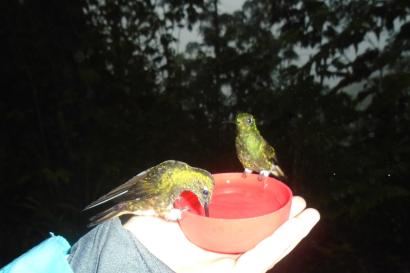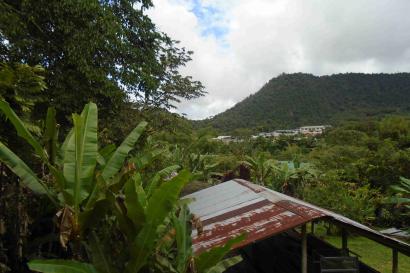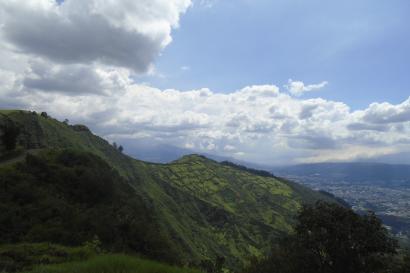After 3 months and 3 classes, Monday the 22nd of October marked the beginning of our weeklong fall break island hopping with IES Abroad. We set out early that morning to Floreana the southernmost and least populated of the four inhabited islands in the archipelago. The island is similar to San Cristóbal with an arid coastline but relatively lush highlands. We stayed for only a few hours to tour the old settlements in the highlands and snorkel at the black sand beach. From its early history as a haven for buccaneers searching for water to tales of intrigue and murder between German settlers in the 1930’s, Floreana likely has the most interesting human history of all the islands. With a population of less than 200 it's probably one of the most remote places I’ve ever been as well. We came there by motorboat and the restaurant had limited WiFi, but I still felt marooned. How completely isolated those early settlers must have felt with intermittent letters carried by ships as their only contact with the outside world.
After our brief stay in Floreana we took another long and choppy boat ride to Isabela, the greenest, most volcanically active, and at least in my opinion most beautiful of the islands. Isabela’s surprisingly large too, significantly bigger than the state of Rhode Island. Despite all this, Puerto Villamil, its single town, is actually smaller than Puerto Baquerizo where we’ve been living on San Cristóbal. Even though we only explored a tiny piece of this huge island we were treated to a whole panorama of landscapes. The town itself is bordered on its coastal side by mangroves forests, brackish lagoons where flamingos feed, and a white sand beach that must stretch for at least a mile. In contrast the landscape inland is absolutely barren. As the newest island Isabela is still volcanically active and huge swaths of its lowlands are covered in lava fields on which little more than cactus grow. Although the areas around the town are essentially uninhabitable they are still being put to use. We passed a newly installed solar farm which will replace the islands petroleum fueled power plant in an effort to turn all power generation in the archipelago renewable.
As the highway winds into the highlands, the air becomes cool and misty and the vegetation abundant. From a site called Minas de Azufres we hiked to the rim of the crater of Sierra Negra; the southernmost and most recently active volcano on Isabela. The crater is absolutely massive, my whole hometown could fit inside it two or three times over. I’ve lived around active volcanos my entire life, but I’ve never felt so viscerally close to one as when I stared down from the rim of the crater into the sprawling charred lava field below. I’d like to go back to Isabela before I leave the archipelago. From volcanos to sea, penguins and flamingos, it’s the island which encompasses everything these islands are imagined to be. One day and two face to face with sharks snorkeling trips later we caught the boat to Puerto Ayora on Santa Cruz, the most populous island.
There’s definitely a lot more to do on Santa Cruz than back on San Cristóbal; after almost two months in sleepy Puerto Baquerizo the visit felt like being in Quito again. Shops are everywhere, and the town is filled with tourists. At times It was strange to imagine we were still in the Galápagos, it seemed far too busy and metropolitan. The buildings are more modern, the streets cleaner, and shops and restaurants are pricier than on San Cristóbal. It’s clearly a town geared to visitors but somehow it all doesn’t quite add up to the island life I’ve come to know. One night though, the whole city lost power for about half an hour, our waiter the next day assured us that it never happens more than once a year but based on everybody's completely unshaken reactions I suspect otherwise.
Better than watching tortoises through the fence at the breeding center was seeing them in their natural habitat. We paid to hike a private ranch in the highlands through which dozens of tortoises roam free. The tortoises aren’t owned by anyone, the ranch just happens to be in their natural range and the owners charge a fee for access to the land. It’s a little surreal to see these beasts just going about their slow cumbersome lives. Our final, and my favorite, excursion before leaving Santa Cruz was to Las Grietas. We woke up early to take a water taxi across the bay and hiked past hotels and salt flats to reach a canyon filled with clear blue water. Even though it reaches 10 meters in depth to the bottom, the giant fish there are still visible from the surface. We skipped the normal crowd by going in the morning and had the whole canyon to ourselves. I’m glad Las Grietas was my last impression of Santa Cruz, it’s too bad jumping from the walls is strictly prohibited.

Xavaar Quaranto
<p>I grew up in Eatonville, a small town in Washington just outside the entrance to Mount Ranier National Park, but I moved to Seattle two years ago for college. There's a lot more to do in the city than back home; I've taken dance lessons, played clarinet in a campus band, and this summer I learned how to sail. Exposure to nature here is limited though. I used to go hike in the national park after work, but now I feel like I hardly leave the library! In the Galápagos I plan to spend plenty of time outside both on land and sea.</p>








